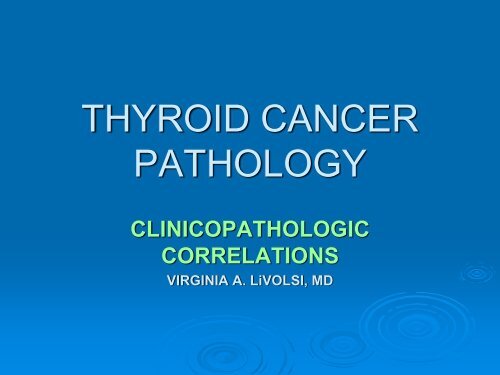Pathologies of Thyroid Cancer
Pathologies of Thyroid Cancer
Pathologies of Thyroid Cancer
Create successful ePaper yourself
Turn your PDF publications into a flip-book with our unique Google optimized e-Paper software.
THYROID CANCER<br />
PATHOLOGY<br />
CLINICOPATHOLOGIC<br />
CORRELATIONS<br />
VIRGINIA A. LiVOLSI, MD
THYROID CARCINOMA<br />
PATHOLOGY<br />
4 Major pathologic types<br />
• FOLLICULAR CELL DERIVED<br />
Papillary carcinoma and variants<br />
Follicular carcinoma<br />
Hurthle cell carcinoma<br />
Anaplastic carcinoma
PAPILLARY THYROID<br />
Clinical<br />
• Any age<br />
CARCINOMA<br />
• Microscopic to large<br />
• Female: Male= 2-4:1<br />
• Radiation history<br />
• Lymph nodes<br />
• Prognosis 95% at 25 years
PAPILLARY THYROID<br />
Gross<br />
• Any size<br />
CARCINOMA<br />
• Confined or extrathyroidal<br />
• May show capsule (especially follicular<br />
variant)<br />
• May be cystic<br />
• May note gross calcification or even<br />
bone
PAPILLARY THYROID<br />
Pathology<br />
CARCINOMA<br />
• Papillae and/or follicles<br />
• Can be totally follicular<br />
• Sclerosis<br />
• Calcification (psammoma bodies)<br />
• NUCLEI
NUCLEI<br />
PAPILLARY THYROID<br />
CARCINOMA<br />
Define the subtype <strong>of</strong> carcinoma<br />
Allow for diagnosis even on small sample<br />
(FNA)
PAPILLARY THYROID<br />
PATHOLOGY<br />
CARCINOMA<br />
• Lymphatic invasion early on<br />
• May show vascular invasion also<br />
• Lymph nodes positive over 50% at<br />
diagnosis<br />
• May present as nodal metastasis in neck<br />
especially cystic (confused with<br />
branchial cleft cyst)
PAPILLARY THYROID<br />
CARCINOMA<br />
Despite nodal metastases, prognosis<br />
remains excellent<br />
This is different from any other<br />
malignant tumor in the human body.
PAPILLARY THYROID<br />
SUBTYPES<br />
TALL CELL<br />
CARCINOMA<br />
FOLLICULAR VARIANT<br />
MICROCARCINOMA<br />
OTHERS
PAPILLARY THYROID<br />
CARCINOMA<br />
TALL CELL VARIANT<br />
Older patients<br />
Large tumors<br />
Extrathyroidal<br />
Vascular invasion
FOLLICULAR THYROID<br />
LESIONS<br />
Follicular variant papillary carcinoma<br />
Definition<br />
+/- capsule<br />
+/- Uniform<br />
Follicular pattern<br />
+/- invasion<br />
NUCLEI
FOLLICULAR THYROID<br />
LESIONS<br />
FOLLICULAR VARIANT PAPILLARY<br />
CARCINOMA<br />
Often encapsulated<br />
Less lymph node mets (25% vs 55%)<br />
More vascular invasion (20%)<br />
More risk <strong>of</strong> distant mets-especially to<br />
bone
PAPILLARY<br />
MICROCARCINOMA<br />
DEFINED BY SIZE: 1 cm or less<br />
Usually incidental finding<br />
Can be found in up to 35% <strong>of</strong> adult<br />
thyroids<br />
Virtually never <strong>of</strong> clinical significance<br />
Should not be over treated.<br />
SUGGESTED DX: MICROTUMOR
FOLLICULAR THYROID<br />
Follicular carcinoma<br />
Definition<br />
LESIONS<br />
• Capsule (thick, <strong>of</strong>ten calcified)<br />
• Solitary<br />
• Uniform<br />
• INVASION
FOLLICULAR CARCINOMA<br />
CURRENT<br />
CLASSIFICATION<br />
Minimally invasive<br />
(gross encapsulation)<br />
Widely invasive<br />
NEW<br />
CLASSIFICATION<br />
Minimally invasive<br />
(capsule only)<br />
Angioinvasive grossly<br />
encapsulated<br />
Widely invasive
FOLLICULAR THYROID<br />
LESIONS<br />
FOLLICULAR CARCINOMA<br />
Capsule invasion only<br />
Very rare if only capsule invasion to<br />
recur or metastasize
FOLLICULAR THYROID<br />
LESIONS<br />
FOLLICULAR CARCINOMA<br />
VASCULAR INVASION
MEDULLARY CARCINOMA<br />
Not <strong>of</strong> follicular cell origin, but C-cell<br />
origin<br />
Secrete calcitonin (tumor marker)<br />
Can be familial (20-25%)<br />
Screening possible<br />
Sporadic cases significant risk 50-60%<br />
survival at 5 years.
CALCITONIN
MEDULLARY CARCINOMA<br />
SCREENING<br />
For patient allows to have evaluation <strong>of</strong><br />
other endocrine lesions and their<br />
treatment<br />
For relatives, allows early diagnosis and<br />
prophylactic surgery AND even surgery in<br />
the premalignant state (C cell hyperplasia).
THE PATHOLOGY REPORT<br />
WHAT YOU AND YOUR<br />
DOCTOR SHOULD EXPECT.<br />
A. Type <strong>of</strong> tumor<br />
B. Size <strong>of</strong> tumor<br />
C. Extent <strong>of</strong> tumor (in or<br />
outside <strong>of</strong> gland)<br />
D. Lymphatic/vascular invasion<br />
E. Presence <strong>of</strong> nodal<br />
metastases
THANK YOU<br />
I appreciate your attention.<br />
ANY QUESTIONS?
THYROID CANCER<br />
PATHOLOGY<br />
CLINICOPATHOLOGIC<br />
CORRELATIONS<br />
VIRGINIA A. LiVOLSI, MD






